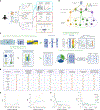SLIDE: Significant Latent Factor Interaction Discovery and Exploration across biological domains
- PMID: 38374265
- PMCID: PMC11588359
- DOI: 10.1038/s41592-024-02175-z
SLIDE: Significant Latent Factor Interaction Discovery and Exploration across biological domains
Abstract
Modern multiomic technologies can generate deep multiscale profiles. However, differences in data modalities, multicollinearity of the data, and large numbers of irrelevant features make analyses and integration of high-dimensional omic datasets challenging. Here we present Significant Latent Factor Interaction Discovery and Exploration (SLIDE), a first-in-class interpretable machine learning technique for identifying significant interacting latent factors underlying outcomes of interest from high-dimensional omic datasets. SLIDE makes no assumptions regarding data-generating mechanisms, comes with theoretical guarantees regarding identifiability of the latent factors/corresponding inference, and has rigorous false discovery rate control. Using SLIDE on single-cell and spatial omic datasets, we uncovered significant interacting latent factors underlying a range of molecular, cellular and organismal phenotypes. SLIDE outperforms/performs at least as well as a wide range of state-of-the-art approaches, including other latent factor approaches. More importantly, it provides biological inference beyond prediction that other methods do not afford. Thus, SLIDE is a versatile engine for biological discovery from modern multiomic datasets.
© 2024. The Author(s), under exclusive licence to Springer Nature America, Inc.
Conflict of interest statement
Competing interests
The authors declare no competing interests.
Figures





Similar articles
-
Unique and shared transcriptomic signatures underlying localized scleroderma pathogenesis identified using interpretable machine learning.JCI Insight. 2025 Apr 8;10(7):e185758. doi: 10.1172/jci.insight.185758. JCI Insight. 2025. PMID: 40197368 Free PMC article.
-
Essential Regression: A generalizable framework for inferring causal latent factors from multi-omic datasets.Patterns (N Y). 2022 Mar 24;3(5):100473. doi: 10.1016/j.patter.2022.100473. eCollection 2022 May 13. Patterns (N Y). 2022. PMID: 35607614 Free PMC article.
-
Iterative single-cell multi-omic integration using online learning.Nat Biotechnol. 2021 Aug;39(8):1000-1007. doi: 10.1038/s41587-021-00867-x. Epub 2021 Apr 19. Nat Biotechnol. 2021. PMID: 33875866 Free PMC article.
-
Machine learning integrative approaches to advance computational immunology.Genome Med. 2024 Jun 11;16(1):80. doi: 10.1186/s13073-024-01350-3. Genome Med. 2024. PMID: 38862979 Free PMC article. Review.
-
Next-Generation Machine Learning for Biological Networks.Cell. 2018 Jun 14;173(7):1581-1592. doi: 10.1016/j.cell.2018.05.015. Epub 2018 Jun 7. Cell. 2018. PMID: 29887378 Review.
Cited by
-
De novo identification of CD4+ T cell epitopes.Nat Methods. 2024 May;21(5):846-856. doi: 10.1038/s41592-024-02255-0. Epub 2024 Apr 24. Nat Methods. 2024. PMID: 38658646 Free PMC article.
-
Machine learning approaches enable the discovery of therapeutics across domains.Mol Ther. 2025 May 7;33(5):2269-2278. doi: 10.1016/j.ymthe.2025.04.001. Epub 2025 Apr 3. Mol Ther. 2025. PMID: 40186352 Review.
-
Unique and shared transcriptomic signatures underlying localized scleroderma pathogenesis identified using interpretable machine learning.JCI Insight. 2025 Apr 8;10(7):e185758. doi: 10.1172/jci.insight.185758. JCI Insight. 2025. PMID: 40197368 Free PMC article.
-
Single-cell genomics and spatial transcriptomics in islet transplantation for diabetes treatment: advancing towards personalized therapies.Front Immunol. 2025 Feb 20;16:1554876. doi: 10.3389/fimmu.2025.1554876. eCollection 2025. Front Immunol. 2025. PMID: 40051625 Free PMC article. Review.
-
Network modeling links kidney developmental programs and the cancer type-specificity of VHL mutations.NPJ Syst Biol Appl. 2024 Oct 3;10(1):114. doi: 10.1038/s41540-024-00445-2. NPJ Syst Biol Appl. 2024. PMID: 39362887 Free PMC article.
References
-
- Altman N & Krzywinski M Regression diagnostics. Nat. Methods 13, 385–386 (2016).
-
- Das J et al. Delayed fractional dosing with RTS,S/AS01 improves humoral immunity to malaria via a balance of polyfunctional NANP6- and Pf16-specific antibodies. Medicine 2, 1269–1286 e1269 (2021). - PubMed
-
- Suscovich TJ et al. Mapping functional humoral correlates of protection against malaria challenge following RTS,S/AS01 vaccination. Sci. Transl. Med. 12, eab4757 (2020). - PubMed
MeSH terms
Grants and funding
- R01 AI170108/AI/NIAID NIH HHS/United States
- P50 AR080612/AR/NIAMS NIH HHS/United States
- DP2AI164325/U.S. Department of Health & Human Services | NIH | National Institute of Allergy and Infectious Diseases (NIAID)
- R01AI170108/U.S. Department of Health & Human Services | NIH | National Institute of Allergy and Infectious Diseases (NIAID)
- DP2 AI164325/AI/NIAID NIH HHS/United States
LinkOut - more resources
Full Text Sources
Molecular Biology Databases

